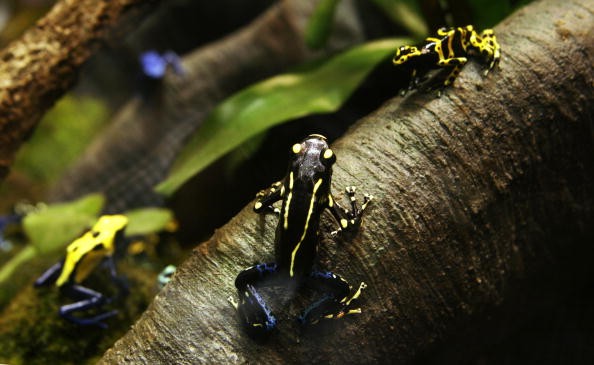Scientists Discover the First Venomous Frogs in Southeast Brazil
| Kwao Peppeh | | Aug 08, 2015 09:11 AM EDT |
(Photo : Photo by Chris Hondros/Getty Images) Scientists have discovered two unique species of venomous frogs in Brazil's Goytacazes National Reserve.
Scientists have discovered two new venomous tree frog species with spines on their heads, which they can use to inject poison into assailants.
According to a report published in the science journal Current Biology on Thursday, these species of frogs share a common feature although they are different.
Like Us on Facebook
The frogs have been identified as Aparasphenodon brunoi and Corythomantis greeningi. Both frog species are unique because they release poison in a novel way when they are attacked or threatened.
The Aparasphenodon brunoi and the Corythomantis greeningi both attack assailants with a row of spines on their skulls. These spines can pierce the skin of any predator that ventures too close.
Other frog species usually secrete poison through their skin.
Researchers say the venom released by A. brunoi is considerably more powerful than that released by C. greeningi. And unlike the A. brunoi, the C. greeningi species has developed more spines on its dome and has an enlarged skin gland which secretes venom. However, the A. brunoi has a more toxic skin.
Scientists have not yet been able to ascertain the amount of toxins these frogs possess and how many times they can strike a predator. However, researchers have already identified that the venom they secrete is more lethal than that of a pit viper.
According to Dr. Carlos Jared and Dr. Edmund Brodie of Utah State University, one gram of toxin produced by A. brunoi would be able to kill up to 80 humans.
"It is unlikely that a frog of this species produces this much toxins, and only very small amounts would be transferred by the spines into a wound," Dr. Brodie said. "Regardless, we have been unwilling to test this by allowing a frog to jab us with its spines."
The researchers stumbled on the frogs after Dr. Jared suffered a sting from a C. greeningi spine while handling frogs in a national reserve in Southeastern Brazil. The injury reportedly led to an intense pain which spread through his arm, lasting about five hours.
Although scientists have been aware of these species of frogs for decades, they were previously unaware of their venomous skull spines.
TagsGreening's frog, Venomous Frogs, Aparasphenodon brunoi, Corythomantis greeningi, Bruno's casque-headed frog
©2015 Chinatopix All rights reserved. Do not reproduce without permission
EDITOR'S PICKS
-

Did the Trump administration just announce plans for a trade war with ‘hostile’ China and Russia?
-

US Senate passes Taiwan travel bill slammed by China
-

As Yan Sihong’s family grieves, here are other Chinese students who went missing abroad. Some have never been found
-

Beijing blasts Western critics who ‘smear China’ with the term sharp power
-

China Envoy Seeks to Defuse Tensions With U.S. as a Trade War Brews
-

Singapore's Deputy PM Provides Bitcoin Vote of Confidence Amid China's Blanket Bans
-

China warns investors over risks in overseas virtual currency trading
-

Chinese government most trustworthy: survey
-

Kashima Antlers On Course For Back-To-Back Titles
MOST POPULAR
LATEST NEWS
Zhou Yongkang: China's Former Security Chief Sentenced to Life in Prison

China's former Chief of the Ministry of Public Security, Zhou Yongkang, has been given a life sentence after he was found guilty of abusing his office, bribery and deliberately ... Full Article
TRENDING STORY

China Pork Prices Expected to Stabilize As The Supplies Recover

Elephone P9000 Smartphone is now on Sale on Amazon India

There's a Big Chance Cliffhangers Won't Still Be Resolved When Grey's Anatomy Season 13 Returns

Supreme Court Ruled on Samsung vs Apple Dispute for Patent Infringement

Microsoft Surface Pro 5 Rumors and Release Date: What is the Latest?













